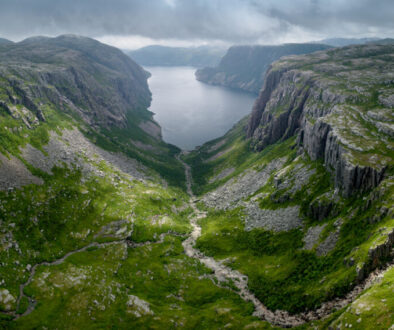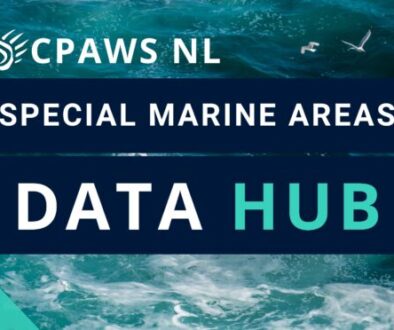Big Triangle Pond Road Development Concerns
The Newfoundland and Labrador Chapter of the Canadian Parks and Wilderness Society (CPAWS-NL) is concerned about a mineral exploration access road that is now under construction on the Avalon Peninsula in the area of Big Triangle Pond, less than an hour’s drive from St. John’s. The area of land in question measures about 50 square kilometres. It is bounded by the Hawke Hills Ecological Reserve in the east, the Salmonier Line in the west, the Trans Canada Highway in the north, and the Avalon Wilderness Reserve and Salmonier Nature Park in the south. The region contains within it portions of two watersheds, the Salmonier River watershed and the North Arm River watershed, both of which are well-known salmon bearing rivers. Not far to the south of this area are the calving and wintering grounds of the Avalon Caribou Herd, whose numbers have been dangerously low for some years now.
There are many who value this land for its wilderness qualities. The value that Eagle Ridge International places on this land requires the transformation and destruction of its wilderness qualities. Eagle Ridge’s construction of a mineral exploration access road, which could eventually lead to the construction of a mine and associated infrastructure, infringes upon the value this land has for many other people.
It is important to recognize that a significant number of people who value this area and have a history with it were not properly consulted regarding the construction of the road. The people who value this land for its natural wilderness qualities justly deserve an opportunity to provide input and express their concerns regarding this development. Such consultation would be possible if the provincial government were to require an Environmental Impact Statement for the construction of the road.
In 2014, the former provincial Progressive Conservative government allowed the construction of the road without an Environmental Impact Statement. In 2016 the newly elected provincial Liberal government required an Environmental Impact Statement for this development. Then, at the end of August 2018, a Supreme Court ruling reinstated the former Progressive Conservative government’s decision and released the proposal by Eagle Ridge International from the requirement of an Environmental Impact Statement.
In response to the Big Triangle Pond road development and planned mineral exploration activities of Eagleridge International Limited within the central Avalon Peninsula region, we at the Newfoundland and Labrador Chapter of the Canadian Parks and Wilderness Society (CPAWS-NL) are concerned about the lack of appropriate assessment of environmental impacts. In particular, we are troubled by the lack of due diligence exercised by the Government of Newfoundland and Labrador and the Supreme Court of Newfoundland and Labrador to oblige Eagleridge International to develop a management plan that would mitigate their impacts on one of the most endangered lichens in the world, Boreal Felt Lichen (Erioderma pedicellatum). We believe that Eagleridge has underestimated the impacts of their activities on this region’s valued ecological components.

Historically, Boreal Felt Lichen was abundant in the forests of Norway, Sweden, New Brunswick, Nova Scotia, and Newfoundland. Due to land use changes, including forestry activities and road development, and declining air quality, populations of Boreal Felt Lichen have disappeared from most of Europe and North America. The island of Newfoundland contains the largest known populations of Boreal Felt Lichen in the world.
Today, Boreal Felt Lichen is red listed by the International Union for Conservation of Nature and considered “critically endangered,” one listing away from “extinct in the wild.” As well, Boreal Felt Lichen is designated by the Committee on the Status of Endangered Wildlife in Canada and listed by the Federal Species at Risk Act as Special Concern in Newfoundland and Labrador and Endangered elsewhere in Canada. Although Boreal Felt Lichen is not afforded additional protections under the N.L. Endangered Species Act, it is irresponsible to ignore opportunities to protect important habitat and to employ current best available practices for protection.
If conservation mishaps have taught us anything is that to conserve a species we need to protect important habitat properly. This last remaining Boreal Felt Lichen habitat on the Avalon Peninsula is critical to the global survival of the species.
Most urgently, there is a need to re-examine the work outlined in the 2015 Lichen Survey Report supplied by Eagleridge in their Environment Protection Plan document. At the time, Eagleridge’s methods followed an accepted standard survey protocol. Since then, however, new methods have been developed that increase the probability of detecting Boreal Felt Lichen. Current research published in the peer-reviewed journal Forest Ecology and Management compared different survey methods of detecting Boreal Felt Lichen. Notably, the methods used by Eagleridge had considerably less effective detection rates compared to new methods. The 2014-2015 lichen surveys performed by Eagleridge along the 11 km proposed road located five individuals of Boreal Felt Lichen in nine days.
In comparison, using improved survey methods in 2019, researchers from Memorial University of Newfoundland located an additional three individuals of Boreal Felt Lichen along the road in only three hours.
We urge the provincial government to enact precautionary measures that limit the impact of Eagleridge International Limited on Boreal Felt Lichen habitat.
More specifically, we think all road construction and mineral exploration work should halt until a comprehensive survey using new methods for the detection of Boreal Felt Lichen is completed.
Written by: Aaron O’Brien and Travis Heckford
CPAWS-NL Directors



